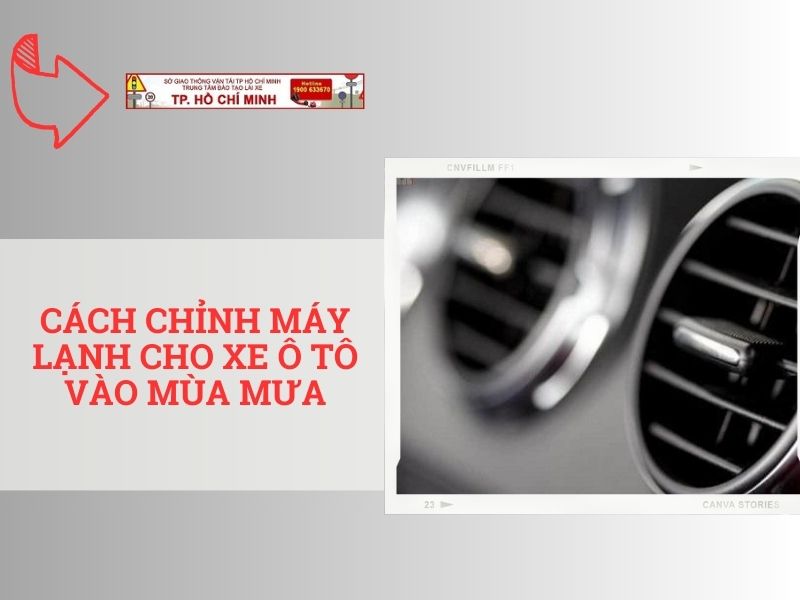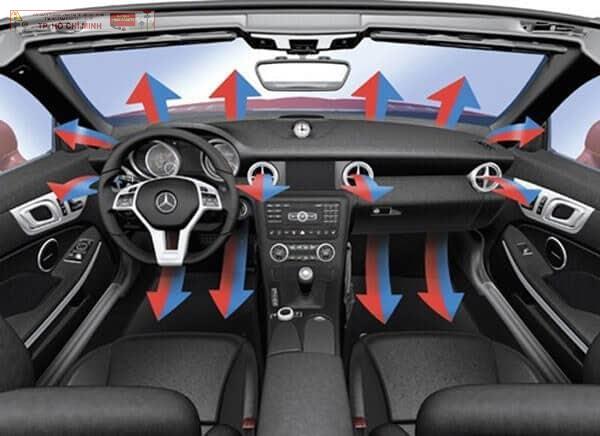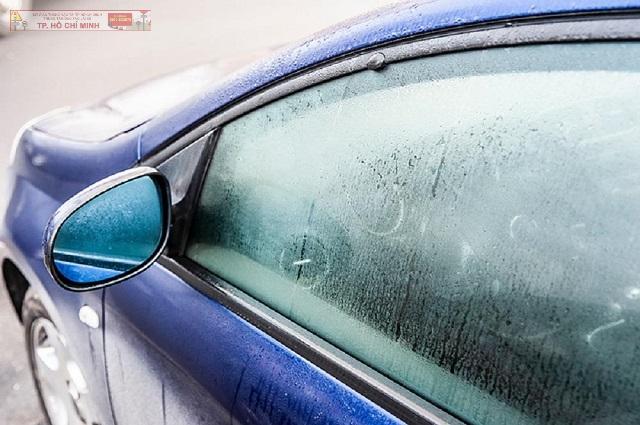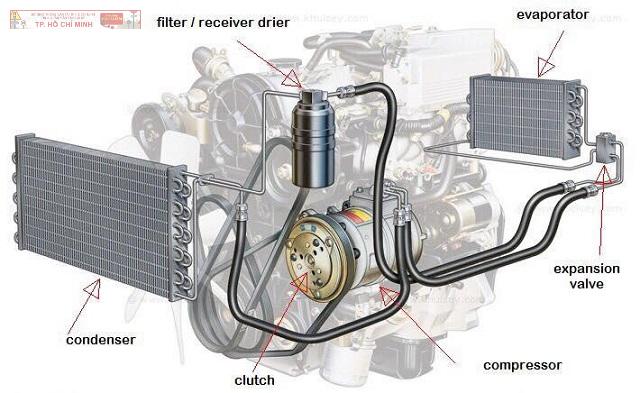Car air conditioning, also known as the air conditioning system, is an important part that helps regulate the temperature and humidity in the vehicle compartment, creating a comfortable feeling for the driver and passengers.
According to research by the US National Highway Traffic Safety Administration (NHTSA), high temperatures in the car can affect the driver's ability to concentrate, increasing the risk of accidents. Using air conditioning helps maintain alertness and improves driving ability.
In the rainy season, high humidity easily makes the air conditioning system work ineffectively, causing noise, odors and extremely unpleasant moldy smells, not only affecting the engine and causing damage over time. harmful to the health of vehicle users.
Therefore, adjusting the air conditioner for cars is extremely important, helping to ensure cooling efficiency, reduce glass fogging, protect the engine system, save fuel and ensure a safe environment for passengers. people in the car.
To effectively adjust the cooling system during the rainy season, car owners should consider adjusting the temperature and wind mode, limit the use of heating mode, and take advantage of the window drying function to keep the car space airy and the vehicle's windows clear. no fog. At the same time, regularly care and maintain the air conditioning system carefully to ensure operating efficiency.
If you don't know how to adjust the air conditioner to ensure safety and save fuel when driving in wet weather conditions? Follow the following article now to ensure comfort and safety for yourself and your companions when traveling by car during the rainy season.
General Condition of Car Air Conditioners During the Rainy Season
In the rainy season, car air conditioners can lose cooling efficiency, produce bad odors due to mold, and make noise when operating because the machine has to operate at too much capacity. The above condition of the air conditioner will cause the car to consume more fuel, reduce the vehicle's performance and cause costs. Not only that, users' health is also affected.

The above phenomenon could be due to several reasons:
- The car is not cool, not cooled evenly, or the cold air is weak, which could be due to a dirty air filter that hinders air circulation, or that the evaporator and condenser are covered with dust, affecting the ability to exchange heat.
- Makes unusual noises or strange sounds when turning on the air conditioner. The cause may be dust or dirt stuck to the fan or the condenser being overworked to compensate for the cooling effect.
- The air conditioner operates with bad odors emitted from the air vents due to bacteria and mold produced by a humid environment during the rainy season.
- Cold air that smells damp is a sign that the air conditioner's drainage system is clogged.
The above reasons cause air conditioners to consume a large amount of fuel for cooling, reducing the functionality of some parts over time and increasing vehicle usage costs.
Why Should You Adjust Your Car's Air Conditioner During the Rainy Season?
In the rainy season, adjusting the car's air conditioning is extremely important, because it not only ensures cooling efficiency, reduces glass fogging, protects the engine system, but also saves fuel for the car. Above all, it also helps protect the health of car users.
Adjusting your car's air conditioning during the rainy season brings the following benefits:
- The rainy season often has high humidity, making vehicle cooling more difficult and vehicle windows often foggy. Adjusting the air conditioner reduces the phenomenon of fogged vehicle windows, bringing safety to the driver and comfort to passengers, ensuring cooling efficiency throughout the operation of the air conditioner.
- Frequent use of air conditioning during the rainy season can cause the system to overload, leading to damage. Adjusting the air conditioner helps protect the components of the cooling system and increases service life.
- Fuel consumption will be significantly reduced because the air conditioner does not have to increase capacity to cool.
- The humid environment in the car is a favorable condition for mold and bacteria to grow, directly affecting the respiratory system and skin-related diseases. Adjusting the air conditioner helps remove moisture and deodorize, creating a fresh environment for the car and protecting the user's health.
In particular, the adjusted cooling system will ensure the appropriate temperature, creating a comfortable and safe driving space for the driver. Using the vehicle when the temperature inside the vehicle is too high or too low, the driver will feel uncomfortable and lose concentration, leading to a high risk of traffic accidents. According to the World Health Organization (WHO), the ideal temperature in a car is about 22-25 degrees Celsius.
Tips for Effectively Adjusting Your Car's Air Conditioner During the Rainy Season
During the rainy season, high humidity makes it more difficult to cool the car and causes common problems such as foggy windows, bad smells, noise, and the car not being cooled. You need to adjust the temperature and wind direction appropriately as well as take care of your car properly for the air conditioner to work most effectively.
1. How to effectively adjust the temperature and wind direction of a car air conditioner during the rainy season?
To effectively adjust the cooling system during the rainy season, car owners should consider adjusting the temperature and wind mode to suit the best threshold for the body. At the same time, limit the use of heating mode and take advantage of the glass drying function to keep the car space airy and the car glass not fogged up.

- Tips for adjusting the temperature and wind mode of air conditioners for cars during the rainy season that car owners should know by heart:
Turn on the air conditioner and adjust the temperature: Turn on the air conditioner and adjust the temperature to an appropriate level, ranging from 23 to 25 degrees Celsius, to reduce the difference with the outdoor temperature. This helps reduce condensation caused by temperature differences. - Select internal air intake mode: Select internal air intake mode to prevent moisture from outside from entering the car. Moisture from outside is the main cause of condensation on the windshield.
- Adjust the wind direction: Adjust the direction of the air vents to ensure that the wind does not blow directly into the car's window positions from the driver's windshield to the side windows. This helps prevent the glass from getting cold and increases the likelihood of condensation.
- Limit the use of heating mode: Avoid using the air conditioner in heating mode because it can cause condensation to occur faster and more. Heating mode will increase the humidity in the car, creating conditions for water vapor to easily condense on the glass.
- Take advantage of the glass drying function: Take advantage of the glass drying function on modern cars to dry the glass quickly. The glass drying function will heat the glass and help steam evaporate quickly.
If there is still condensation, you can place a few desiccant bags in the car or use anti-condensation solution on the windshield to ensure a dry space, clear visibility and safe driving. car.

2. How to effectively take care of the air conditioning system during the rainy season?
Besides adjusting the temperature and wind mode, apply the following tips to ensure the cooling system operates effectively:
- Use dry mode: Dry mode helps remove moisture in the car, preventing mold and bacteria from growing. You should use the drying mode after it rains or when the vehicle is moving in a humid environment.
- Clean the indoor and outdoor units: The indoor and outdoor units are dirty, affecting the ability to exchange heat. You should clean the indoor and outdoor units every 6 months.
- Clean the air filter: A dirty air filter hinders air circulation, reducing cooling efficiency. During use, you should clean or replace the air filter every 3 months or every 5.000 km.
- Use deodorizing solution: Deodorizing solution helps eliminate odors in the car, creating a comfortable feeling for the user. You should use deodorant solution once a month.
- Wash your car regularly, especially after traveling in the rain or through muddy roads to limit oxidation, peeling, and damage to vehicle parts.
If the car owner is experienced and knowledgeable about vehicle structure and knows how to handle it himself, he can do it at home. If not, you should bring the car to the garage for assistance. The technician at the garage will check and instruct you to adjust the car's air conditioner properly.
Notes When Adjusting Your Vehicle's Cooling System
Even though you have experience and knowledge about cars, when adjusting your car's air conditioning, vehicle owners should also "take to heart" a few of the following notes to ensure safety for both the car and people:
- Follow safety instructions when working with the air conditioner and refer to the manufacturer's operating instructions.
- Avoid turning on the air conditioner immediately after starting the car: This will cause the car engine to work harder, leading to fuel wastage and reduced engine life. You should wait about 2-3 minutes after starting the car before turning on the air conditioner.
- Turn off the air conditioner before turning off the car engine: This helps dry the cooling system, avoiding mold and odors.
- Do not adjust the air conditioner too much, use the appropriate wind mode to avoid catching a cold. This both affects health and increases fuel consumption.

In addition, while using a car, car owners should properly use the functions and modes of the air conditioner, limit turning on the air conditioner when not necessary and take in fresh air when the weather is dry. If there is Eco mode, turn it on to save fuel, help you save costs and protect the environment. At the same time, you should periodically use deodorant solution or hang a desiccant bag to create a ventilated and fresh environment for the car.
Theo (The National Renewable Energy Laboratory) is the energy research laboratory of the US Department of Energy. Their research shows that using air conditioning systems in cars can significantly increase fuel consumption, leading to increased emissions and the greenhouse effect. According to research, using air conditioning can reduce fuel efficiency by about 2 km/l (about 1 mpg).
Related Questions When Using Car Air Conditioner
1. What causes car air conditioning to work ineffectively?
The reason why a car air conditioner is not working effectively can be due to dirty air filters, lack of or leaking refrigerant gas, accumulated dust and dirt in the condenser and condenser units, or some parts such as fans, electrical systems, and sensors. temperature,... problems or damage. Specifically:
- Dirty air filter: The air filter is not changed periodically or exceeds the standard mileage, causing obstruction of air circulation, reducing cooling efficiency.
- Lack of refrigerant gas or leakage: Lack of refrigerant gas due to operating at excess capacity or leaking during use also reduces the performance of the refrigeration system. Need to check and refill refrigerant gas periodically every 2 years.
- The indoor and outdoor units are dirty: The indoor and outdoor units are dirty, affecting the ability to exchange heat. You should clean the indoor and outdoor units every 6 months.
- Weak fan operation: The fan helps circulate air in the air conditioning system. If it operates weakly, it will lead to weak cooling ability.
- The electrical system has problems: The electrical system provides energy for the air conditioner to operate. When there is a problem or damage, the car air conditioner will not work. The electrical system should be checked and repaired if necessary.
- Broken temperature sensor: The temperature sensor is the part that regulates the temperature in the car. If damaged, the air conditioner may not work effectively.
In addition, a number of other reasons can also cause the car air conditioner to operate ineffectively such as:
- Using inappropriate wind mode.
- Temperature setting is too low.
- Vehicles move in hot environments.
- The air conditioning system is aging.
2. How to use car air conditioning to save fuel?
Improper use of car air conditioning will consume a lot of fuel and money. In order for this system to work effectively and save fuel, you should adjust the temperature and wind mode appropriately, turn on Eco mode in the car (if available) and only use the air conditioner when necessary. In particular, you should follow the vehicle cleaning and maintenance schedule to ensure that all parts of the vehicle are operating at their proper capacity, without being "overworked", both ineffective and costly.
In addition, you should also be careful not to leave your car in the sun for too long, use a sunshade when parking, and keep the car compartment well ventilated.
3. What is the best temperature level to adjust the air conditioner to?
The best air conditioning temperature is from 24°C to 26°C. This temperature level not only helps you feel comfortable, but also saves fuel and protects the vehicle engine.
4. Should I use inside or outside air intake mode?
When it rains, you should use the internal air intake mode to avoid moisture from outside entering the car, causing fogging of the windshield. When it's dry, you can use the outside air mode to provide fresh air to the car.
5. Should I use the glass drying function regularly?
You should only use the windshield drying function when necessary, for example when the windshield is fogged by moisture. Using the glass drying function frequently can shorten the life of the air conditioning system.
6. Where is a reputable place to learn how to drive a car in HCM?
If you are not confident with the steering wheel, you are not proficient driving skills Or control systems on cars, you can learn additional driving lessons here City Driving Test & Training Center. Ho Chi Minh City.
Register to study at the City Driving Training & Testing Center. HCM, you will experience effective lessons in a spacious environment with the dedicated guidance of a team of enthusiastic and experienced teachers.

In particular, the center also picks up and drops students off at many points for practical training and visual training in many routes and weather conditions, which is extremely convenient and saves time, money and effort.
If you need to learn more about driving or take a driver's license test, contact the hotline number of the City Driving Training & Testing Center. HCM for dedicated and thoughtful support. See details about Address for additional car driving in HCM Prestigious, cheap, flexible class hours from Monday to Sunday.
Above is all the necessary information when adjusting car air conditioning in the rainy season, hopefully helping readers "pocket" a few repair tips when necessary. Follow our website for more great tips when using a car.
 Driving test & training school in Ho Chi Minh City Training, teaching and driving test school in Ho Chi Minh City
Driving test & training school in Ho Chi Minh City Training, teaching and driving test school in Ho Chi Minh City






